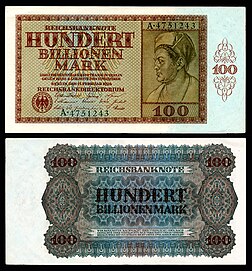| Mark (German) | |
|---|---|
 100 trillion-ℳ︁ note, 1924 (short scale (US) or 100 billion-ℳ︁ long scale (UK pre-1974, Germany, much of Europe) | |
| Unit | |
| Plural | Mark |
| Symbol | ℳ︁ |
| Denominations | |
| Subunit | |
| 1⁄100 | Pfennig |
| Plural | |
| Pfennig | Pfennig |
| Symbol | |
| Pfennig | ₰ |
| Banknotes | 1ℳ︁, 2ℳ︁, 5ℳ︁, 10ℳ︁, 20ℳ︁, 50ℳ︁, 100ℳ︁, 500ℳ︁ 1,000ℳ︁, 5,000ℳ︁, 10,000ℳ︁, 20,000ℳ︁, 50,000ℳ︁, 100,000ℳ︁, 200,000ℳ︁, 500,000ℳ︁ 1-million-ℳ︁, 2-million-ℳ︁, 5-million-ℳ︁, 10-million-ℳ︁, 20-million-ℳ︁, 50-million-ℳ︁, 100-million-ℳ︁, 500-million-ℳ︁ 1-billion-ℳ︁, 5-billion-ℳ︁, 10-billion-ℳ︁, 20-billion-ℳ︁, 50-billion-ℳ︁, 100-billion-ℳ︁, 200-billion-ℳ︁, 500-billion-ℳ︁ 1-trillion-ℳ︁, 2-trillion-ℳ︁, 5-trillion-ℳ︁, 10-trillion-ℳ︁, 20-trillion-ℳ︁, 50-trillion-ℳ︁, 100-trillion-ℳ︁ |
| Coins | 1₰, 2₰, 5₰, 10₰, 50₰ (1⁄2ℳ︁) 1ℳ︁, 3ℳ︁, 200ℳ︁, 500ℳ︁ |
| Demographics | |
| Replaced | German mark (1871) |
| Replaced by | Rentenmark |
| User(s) | |
| Issuance | |
| Central bank | Reichsbank |
| Valuation | |
| Pegged with | United States dollar = 4.2-trillion-ℳ︁ = RM4.20 (1 trillion short scale (US) or 1 billion long scale (UK pre-1974, Germany, much of Europe) = 1,000,000,000,000) |
| This infobox shows the latest status before this currency was rendered obsolete. | |
The Papiermark (German: [paˈpiːɐ̯ˌmaʁk] ; lit. 'paper mark', officially just Mark, sign: ℳ︁) was the German currency from 4 August 1914[1] when the link between the Goldmark and gold was abandoned, due to the outbreak of World War I.[2] In particular, the Papiermark was the currency issued during the hyperinflation in Germany of 1922 and 1923.[3]
- ^ Knapp, George Friedrich (1924), The State Theory of Money, Macmillan and Company, pp. vxi
- ^ Patrick Spread (29 December 2022). Economics, Anthropology and the Origin of Money as a Bargaining Counter. Taylor & Francis 2022. p. 290. ISBN 9781000770841.
- ^ Randall E. Parker; Robert M. Whaples (2013). Routledge Handbook of Major Events in Economic History. Routledge. p. 372. ISBN 9781135080792.